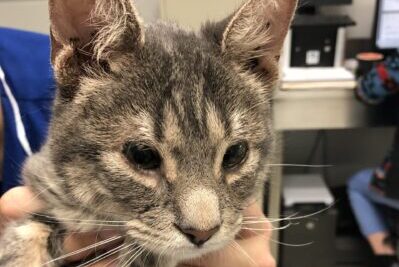Lost in Translation

Lost in Translation
Veterinarians request a lot of information from pet owners. We interrogate them: What does his cough sound like? We dictate to them: Give these pills three times a day. And we expect them to understand a foreign language — doctor talk. Mistranslated doctor talk results in communication gaps between veterinarians and pet owners. Here are some examples from last week’s patient visits at The Animal Medical Center.
Barfy is regurgitating twice a day.
This “lost in translation” example comes from the innocent misuse of the word regurgitate. Medically speaking, regurgitate is similar to vomiting, but there is an important difference. When a dog regurgitates, a forceful heave-ho and wretch are missing. The food or liquid comes back up without an increase in abdominal pressure. Picky, I know, but, as a veterinarian, this information is diagnostically critical. Dogs and cats that regurgitate have an esophageal problem, and those that vomit typically have a problem further down the digestive tract. This picky distinction directs my diagnostic evaluation, so I have to get it right or I bark up the wrong diagnostic tree, so to speak.
Is Fluffy urinating more than usual?
This translation gap was my fault. The poor cat owner didn’t know how to answer. Was I asking more in frequency or more in volume? I tried to avoid using doctor talk to ask what was really on my mind; was Fluffy pollakiuric or polyuric, the special words for increased frequency of urination or increased volume of urination. Increased volume of urination suggests diseases like diabetes, kidney failure or a kidney infection. Increased frequency of urination suggests a bladder infection, bladder stones or possibly a bladder tumor. Once again picky, but critical.
My cat, Peter, gets dialysis at home every other day.
This comment was made by a patient new to The AMC and it caught me off guard. The AMC is the only center for dialysis between Boston and Philadelphia and this cat was a local from 89th Street in Manhattan. Dialysis happens in the hospital and not at home. What really happened was the owner had been trained by her regular veterinarian to give fluids subcutaneously to her cat to help combat the effects of failing kidneys. Cats with kidney disease often become dehydrated as their failing kidneys waste water by producing excessive amounts of urine. Supplementing feline fluid intake with subcutaneous fluids keeps cats feeling and eating better because they are not dehydrated. Dialysis, also used to treat failing kidneys, filters the blood through a machine to remove waste product since the kidneys no longer perform this function. Same disease, different treatment.
If you are not sure what your pet’s veterinarian just told you or can’t understand the question you were just asked, don’t hesitate to ask for clarification. Don’t let your pet’s diagnosis get lost in translation.


































